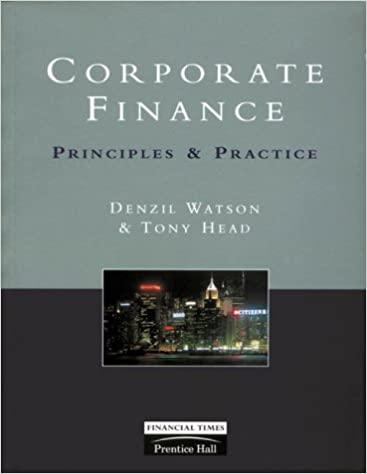DI A52 Xfx (b) Estimate NPV, IRR and Payback period of the pr A 4 NPV 45 IRR 46 Payback Period 47 48 Q#1 Would you accept the project based on NPV, IRR? Would you accept the project based on Payback rule if project cut-off period 49 is 3 years? Q#2 SENSITIVITY and SCENARIO ANALYIS: Capital Budgeting 50 (Investment ) Decisions (a) Estimate NPV, IRR and Payback period of the project if the Marginal Corporate Tax is reduced to 20%. Would you accept or 51 reject the project? Assume Straight-Line Depreciation. (b) Estimate NPV, IRR and Payback period of the project if Equipment is fully depreciated in first year and tax rate is 52 reduced to 20%. Would you accept or reject the project? (c) As a CFO of the firm, which of the above two scenarios (a) or 53 (b) would you choose? Why? 54 Q#3 Explain to your CEO what the NPV results mean. Q#4 What are the advantages and disadvantages of using only 55 the Payback method? Q#5 What are the advantages and disadvantages of using NPV 56 versus IRR? Q16 Explain the difference between independent projects and mutually exclusive projects. When you are confronted with Mutually Exclusive Projects and have conflicts with NPV and IRR 17 results, which criterion would you use (NPV or IRR) and why? 69 Question E == AS2 fx (b) Estimate NPV, IRR and Payback period of the project if Equipment is fully depreciated in first year and tax rate is reduced to A B D 4 $(200,000) $ (35,000) $ (5,000) $ 25,000 $ 5,000 $ 15,000 $ 200,000 5% 60.00% $ (60,000) 35% 10% 1) Project Life (years) 2) New equipment cost 10 3) Shipping & installment costs 11 4) Related start up cost 12 5) Inventory Increase 13 6) Accounts Payable increase 147) Equip. Salvage Value Estimated at the End of Year 4 15 8) Sales for first year (1) 169) Sales increase per year 17 10) Operating cost (60 Percent of Sales) 18 11) Depreciation Straight Line = Initial Cost/YR 19 12) Tax rate 2013) Cost of Capital (WACC) 21 22 YEAR 23 Equipment cost 24 Shipping and Install cost 25 Start up expenses Total Capital Spending 27 After Tax Salvage Value in Year 4: Salvage - T(Salvage - Book Value) 20 Net Working Capital (Inventory Increase - A/P Increase) 26 30 Pro-Forma Income Statement 3: Revenue 22 Operating Cost 39 Depreciation 34 EBIT 35 Taxes 26 Net Income (LOSS) 1 2 0 $(200,000) $ (35,000) $ (5,000) $(240,000) 26 $ (20,000) 2 $ 20,000 $ 200,000 $210,000 $ 220,500 $ 231,525 $(120,000) $ (60,000) $ 20,000 $ 7,000 $ 13,000 Question Sheet1 + DI A52 Xfx (b) Estimate NPV, IRR and Payback period of the pr A 4 NPV 45 IRR 46 Payback Period 47 48 Q#1 Would you accept the project based on NPV, IRR? Would you accept the project based on Payback rule if project cut-off period 49 is 3 years? Q#2 SENSITIVITY and SCENARIO ANALYIS: Capital Budgeting 50 (Investment ) Decisions (a) Estimate NPV, IRR and Payback period of the project if the Marginal Corporate Tax is reduced to 20%. Would you accept or 51 reject the project? Assume Straight-Line Depreciation. (b) Estimate NPV, IRR and Payback period of the project if Equipment is fully depreciated in first year and tax rate is 52 reduced to 20%. Would you accept or reject the project? (c) As a CFO of the firm, which of the above two scenarios (a) or 53 (b) would you choose? Why? 54 Q#3 Explain to your CEO what the NPV results mean. Q#4 What are the advantages and disadvantages of using only 55 the Payback method? Q#5 What are the advantages and disadvantages of using NPV 56 versus IRR? Q16 Explain the difference between independent projects and mutually exclusive projects. When you are confronted with Mutually Exclusive Projects and have conflicts with NPV and IRR 17 results, which criterion would you use (NPV or IRR) and why? 69 Question E == AS2 fx (b) Estimate NPV, IRR and Payback period of the project if Equipment is fully depreciated in first year and tax rate is reduced to A B D 4 $(200,000) $ (35,000) $ (5,000) $ 25,000 $ 5,000 $ 15,000 $ 200,000 5% 60.00% $ (60,000) 35% 10% 1) Project Life (years) 2) New equipment cost 10 3) Shipping & installment costs 11 4) Related start up cost 12 5) Inventory Increase 13 6) Accounts Payable increase 147) Equip. Salvage Value Estimated at the End of Year 4 15 8) Sales for first year (1) 169) Sales increase per year 17 10) Operating cost (60 Percent of Sales) 18 11) Depreciation Straight Line = Initial Cost/YR 19 12) Tax rate 2013) Cost of Capital (WACC) 21 22 YEAR 23 Equipment cost 24 Shipping and Install cost 25 Start up expenses Total Capital Spending 27 After Tax Salvage Value in Year 4: Salvage - T(Salvage - Book Value) 20 Net Working Capital (Inventory Increase - A/P Increase) 26 30 Pro-Forma Income Statement 3: Revenue 22 Operating Cost 39 Depreciation 34 EBIT 35 Taxes 26 Net Income (LOSS) 1 2 0 $(200,000) $ (35,000) $ (5,000) $(240,000) 26 $ (20,000) 2 $ 20,000 $ 200,000 $210,000 $ 220,500 $ 231,525 $(120,000) $ (60,000) $ 20,000 $ 7,000 $ 13,000 Question Sheet1 +








